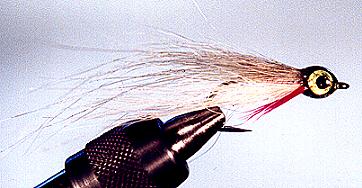|
This is a local variation of a standard fly known as a 'Dark over Light'
streamer. Who originated it and where this general pattern came from is not
known. It was probably 'invented' by many, in several regions, at various
times in all parts of the fly fishing world. It seems to be a product of necessity
rather than some dreamed up creation. It well imitates many of the bait fish
found in waters all around the world. At least in some form or other.
The colors can be arranged to more closely match the bait in your region.
This fly is tied with natural and dyed Polar Bear, not the easiest fur to find.
But, worth the search.
If you have not yet used epoxy for a head this is a great time to give
it a try; tie up half a dozen, show off the last one and fish the first five.
There are many possible ways to create the head. It is important to use
'Five-Minute' epoxy though! Not to do so will produce problems you
do not even want to consider. ~ J Castwell
Materials List:
Hook: Any size 2 to 4 salt water hook
(this was tied with a Daiichi X452 #4).
Thread: Dark green Kevlar.
Body: Silver Tinsel.
Lower wing: White Polar Bear.
Upper Wing: Dyed Polar Bear.
Throat: Bright red saddle hackle.
Eye: Stick-on type.
Head: Five-minute epoxy (any brand).
Tying Instructions:
1. Start right off by bending down the barb if that is your preference for the fly,
later is a poor choice as you may break the hook.
2. Solidly secure the hook, apply a coat of head-cement to the shank and
wind the thread to the back.
3. Tie in the tinsel and wind the thread forward to where the head will start.
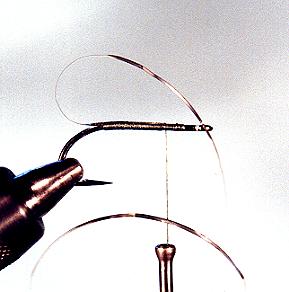 4. Apply another coat of head-cement to the thread and bring up the tinsel
and tie it off.
5. Select a bunch of white fur and take a turn around it before you
place it against the bottom of the hook. The turn will keep it under the hook.
6. Tie in the red throat with two more turns of thread.
4. Apply another coat of head-cement to the thread and bring up the tinsel
and tie it off.
5. Select a bunch of white fur and take a turn around it before you
place it against the bottom of the hook. The turn will keep it under the hook.
6. Tie in the red throat with two more turns of thread.
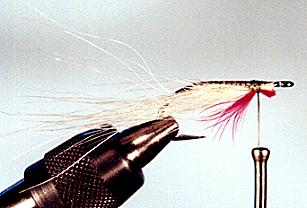
7. The dyed Polar Bear now goes on top with a turn around it before
it goes against the hook. Secure with two turns only.
8. Important; Apply head-cement to the junction of the dyed Polar Bear,
white Polar Bear, and red throat. While it soaks in bind down the three
with several turns of thread.
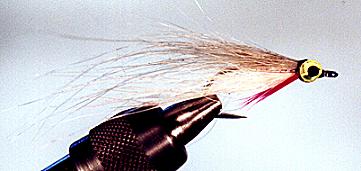 9. Build up the head carefully, watching as the layers of thread form
a neat head. Use a whip-finish for the last few turns.
9. Build up the head carefully, watching as the layers of thread form
a neat head. Use a whip-finish for the last few turns.
10. Select the stick-on eyes of your choice, kink the eyes a bit so as
to help them form to the head and apply.
11. Mix the epoxy and apply a large drop of it on top of the head.
Continue to add as much as you can and turn the fly at the same time.
Let the epoxy nearly fall off the head as it turns; this keeps the 'drop'
from running forward or backward and forms a nice round ball head.
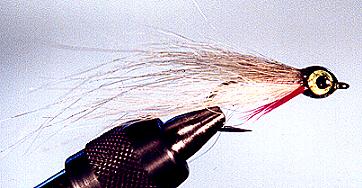 Here is a better picture of the eye.
Here is a better picture of the eye.
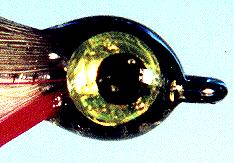 Tips on Fishing Castwell's Marble-head
Tips on Fishing Castwell's Marble-head
Personally I have found that the fly needs no weight, and in fact does
not perform well with any. The retrieve should be so that the fly will
rise and fall back a bit. The fly is perfectly weighted as it is, any added
weight seems to detract from it's effectiveness. The large head and the
very large eye seem to particularly important to the success of the pattern.
I have seen many improvements on the pattern, none of which worked
as well as this pattern.
Be sure to match the color of the TOP of the fly to the bait fish in your
area. This could range from brown, to blue, to green; and all the shades
in between. I fish the fly on fluorocarbon and am surprised at the gentleness
of many of the takes to it. I also always fish it barbless which allows me
to use a size lighter leader and therefore gives the fly a more realistic action.
~ JC
|

